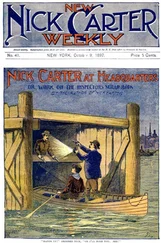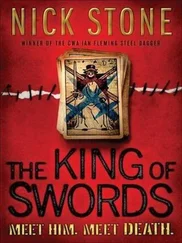Nick Stone - Mr. Clarinet
Здесь есть возможность читать онлайн «Nick Stone - Mr. Clarinet» весь текст электронной книги совершенно бесплатно (целиком полную версию без сокращений). В некоторых случаях можно слушать аудио, скачать через торрент в формате fb2 и присутствует краткое содержание. Жанр: Полицейский детектив, на английском языке. Описание произведения, (предисловие) а так же отзывы посетителей доступны на портале библиотеки ЛибКат.
- Название:Mr. Clarinet
- Автор:
- Жанр:
- Год:неизвестен
- ISBN:нет данных
- Рейтинг книги:3 / 5. Голосов: 1
-
Избранное:Добавить в избранное
- Отзывы:
-
Ваша оценка:
- 60
- 1
- 2
- 3
- 4
- 5
Mr. Clarinet: краткое содержание, описание и аннотация
Предлагаем к чтению аннотацию, описание, краткое содержание или предисловие (зависит от того, что написал сам автор книги «Mr. Clarinet»). Если вы не нашли необходимую информацию о книге — напишите в комментариях, мы постараемся отыскать её.
Mr. Clarinet — читать онлайн бесплатно полную книгу (весь текст) целиком
Ниже представлен текст книги, разбитый по страницам. Система сохранения места последней прочитанной страницы, позволяет с удобством читать онлайн бесплатно книгу «Mr. Clarinet», без необходимости каждый раз заново искать на чём Вы остановились. Поставьте закладку, и сможете в любой момент перейти на страницу, на которой закончили чтение.
Интервал:
Закладка:
He walked down to it. It was a large study, furnished with a desk and computer nearest the door, a library of bound books at the far end, and, in between, a dark green leather armchair and another big television set. A woman was there, working at the computer.
The drawers had all been opened, their contents piled on top of the desk: five bricks of used $100 bills, stacks of photographs, half a dozen CDs-each a different color-and two trays of floppy discs labeled 1961 through 1995.
Max went over to the bookcase, pausing at another portrait of Papa Doc, this one very different from the ones he'd already seen in the house. Here the dictator, dressed like Baron Samedi, in a top hat, tails, and white gloves, sat at the head of a long table in a blood-red room, staring straight at the viewer. Others sat around him, but their faces weren't shown. They were shadowy, ambiguously human forms, rendered in a shade of brown so somber it was practically black. In the middle of the table was a white bundle of some sort. He looked closer at the canvas and recognized a baby.
He looked away and moved over to the bookshelves. The books were arranged in blocks of color-blue, green, red, maroon, brown, and black-and had their titles stamped on the spines in gold letters. He homed in on a title: Georgina A. The book next to it was called Georgina B, the one after, Georgina C. He pulled it out and opened it.
No pages. The "book" was really a video case in disguise, like the kind of hollowed-out Bible he'd known junkies to stash their works and supplies in. Max took out the plain black cassette. A photograph of a scared-looking preteen girl was underneath. He opened cases A and B and found a different photograph in each. In the first, she was smiling at the camera, in the second, she looked confused.
He went through the rest of the shelves. Tapes everywhere, all of them stored in cases branded with girls' names. There were no boys anywhere, no Charlie or Charles A-C.
But he found Claudette T.
And he found Eloise.
"What've you got?" the woman asked from behind the desk. New York accent.
"Videotapes. What about you? What's on the computer?"
"Sales records-everything up to 1985 has been scanned from ledgers. And there's a database on the machine. This couple has been selling kids to men," she said.
"I'll come and look in a minute," Max said, going back to the television. He turned it on and fed Eloise A into the video player.
It was impossible to put a date on the footage, but there were only hints of the adult Eloise in the child whose face filled the screen for at least two solid minutes. She couldn't have been more than five or six then.
Max stopped the tape when the abuse started.
The woman at the desk had stopped working. Her expression, teetering between disgust and despair, told him she'd seen what he had.
"Let's see what you're working on?" Max asked, quickly going over to her.
She showed him her screen-an image of a blank sheet of paper divided into six vertical columns, headed Nom, Age, Prix, Client, Date de Vente, and Addresse. It was from August 1977, and showed which child had been sold to which client and where they'd been taken to.
He quickly scanned this last column: of the thirteen children listed, four had gone either to the U.S. or Canada, two had been taken to Venezuela, one apiece to France, Germany, and Switzerland, three to Japan, one to Australia. The buyers were identified by their full names.
They looked at the database.
It was quite a history.
The database was divided into years, and then subdivided into countries.
Apart from their names, addresses, dates of birth, occupations, and places of employment, there was also a record of the buyers' (called "clients" on the database) salaries, sexual orientation, marital status, number of children, and the names and addresses of their contacts in business, politics, media, entertainment, and other areas.
The first recorded transaction was dated November 24, 1959, when Patterson Brewster III, managing director of The Dale-Green Pickle and Preservatives Company "adopted" a Haitian boy called Gesner Cйsar.
The adoption cost $575.
The most recent adoption recorded was that of Ismaлlle Clouй by Gregson Pepper, a banker from Santa Monica, California.
The cost was $37,500 (S). (S) signified standard service-no frills, no benefits, no shortcuts, no special favors; the buyer chose his "item" (as the children were referred to in the database section listing their details), paid, and left with him or her. The price remained constant and there was no competition for the item.
If one or more other buyers were interested in the same child, then the sale went to auction (A), with the price starting at its current standard rate.
The highest paid for a child at an auction was $500,000 for a six-year-old girl, by the Canadian chief executive of an oil company based in Dubai. That was in March 1992.
Other service categories were: (B), which stood for Bon Ami (good friend), or a buyer who could reserve a child of his choice from the menu, without facing competition. The cost was higher-between $75,000 and $100,000-depending on the child's popularity and the buyer's "additional value" (found in a separate box on the database, below the contacts section: this signified a buyer's clout-his links with governments; someone of high value was charged at the lower end of the scale). (M), Meilleur Ami (best friend), or a buyer who ordered а la carte. He got almost anything he wanted, brought to him from anywhere. For that privilege he could pay anything between $250,000 to $1,000,000.
Many buyers were graded (R)-recurrent purchasers-with numbers indicating the amount of times they had used the service. Most were R3 or R4, but several hit double figures, the highest being an R19.
There were 2,479 buyer names on the database. Of those, 317 came from North America. They included bankers, diplomats, stockbrokers, senior cops, senior clergy, senior military personnel, doctors, lawyers, high-level businessmen, actors, rock stars, movie producers and directors, a media magnate, and one former talk-show host. Max recognized only a handful of the names, but most of the organizations, establishments, and companies they were attached to were household names.
The "menus" consisted of files of photographs of individual children-a head shot and three full body shots-clothed, in underwear, and naked-which were sent to buyers via e-mail. The buyers would reply with their choice.
In the days before the Internet, the buyers had met up at private clubs and had been given the files in paper form. Many preferred this method, because they said e-mails were vulnerable to hackers.
Max next studied a photograph file showing children and their corresponding buyers. The buyers either had been snapped unawares from a distance, or their images had been lifted straight from video footage.
One whole file was devoted to pictures of buyers in or around the place where they kept the children, which Max recognized from the tape he'd found at the Faustin house. They had been photographed meeting and greeting each other, and inspecting the mouths of children standing on what looked like auction blocks. The buyers never looked at the camera, which led Max to think that they were being photographed in secret.
The final photos in the series showed them boarding boats bound for a nearby coastline.
Blackmail, Max thought immediately.
"Do you know where that is?" Max asked.
"Looks like these photos were taken on La Gonвve. It's an island off the coast."
"Could you look up a name for me on the database. First name Claudette-two ts-last name Thodore."
The woman brought up her details and printed them out. Claudette had been sold to a John Saxby in February 1995. He lived in Fort Lauderdale, Florida.
Читать дальшеИнтервал:
Закладка:
Похожие книги на «Mr. Clarinet»
Представляем Вашему вниманию похожие книги на «Mr. Clarinet» списком для выбора. Мы отобрали схожую по названию и смыслу литературу в надежде предоставить читателям больше вариантов отыскать новые, интересные, ещё непрочитанные произведения.
Обсуждение, отзывы о книге «Mr. Clarinet» и просто собственные мнения читателей. Оставьте ваши комментарии, напишите, что Вы думаете о произведении, его смысле или главных героях. Укажите что конкретно понравилось, а что нет, и почему Вы так считаете.












